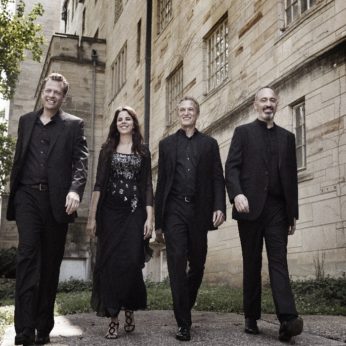Composer: Dmitri Shostakovich (b. 1906 - d. 1975)
Performance date: 26/06/2023
Venue: St. Brendan’s Church
Composition Year: 1944
Duration: 00:34:30
Recording Engineer: Gar Duffy, RTÉ
Instrumentation: 2vn, va, vc
Instrumentation Category:String Quartet
Artists:
Pacifica Quartet (Simin Ganatra, Austin Hartman [violins], Mark Holloway [viola], Brandon Vamos [cello]) -
[String Quartet]

Quartet No 2 in A major Op. 68 [1944]
This quartet was the last of Shostakovich’s war pieces, which began with the famous Leningrad Symphony with Hitler’s armies at the gates, the Eighth Symphony of 1943 and the E minor Piano Trio, which was finished in August 1944. Shostakovich then turned as though diabolically possessed to this Quartet. The two chamber works were written in mourning for his friend, Ivan Sollertinsky, though the Quartet was dedicated to his fellow composer and another loyal friend, Vissarion Shebalin. (In those testing times loyal friends were frighteningly scarce.) Both works were premiered at the same concert in the Great Hall of the Leningrad Philharmonic, where Sollertinsky had been artistic director.
It was while writing this work that Shostakovich wrote to Shebalin worrying about the lightning speed at which he composed: One shouldn’t compose as quickly as I do. Composition is a serious business…It is exhausting, rather unpleasant, and at the end of the day you lack any confidence in the result. But I can’t rid myself of the bad habit.
The difference from the First Quartet is staggering, the slow movement alone is almost as long the whole of the earlier work and the mood of sorrow and lamentation is overwhelming. When the Borodin Quartet played the complete Shostakovich cycle here fifteen years ago they chose to programme this Quartet before the First Quartet, so their first concert in that extraordinary series opened with the wild howl of protest that begins the A major Quartet. This propels the music straight into orbit, a momentum that the strident second theme continues without any let-up in the tension. This short and powerful exposition is repeated before the development is begun in a deceptively restrained manner. This seems to circle around the central drama before driving itself to a desperate climax. The opening cry then leads back into an exhausted recapitulation but manages to revive itself for the coda’s last wild outburst.
The dramatic world of opera is conjured by the movement titles, moving from Overture to Recitative and Romance when the first violin plays the heroine. After his catastrophic confrontation with Stalin over Lady Macbeth, he never again had the confidence to complete a full-length opera, so his dramatic talents had to find other means of expression. The instrumental recitative is also a reminder of Beethoven’s late quartets and the tragic posture betrays the more Russian influence of Tchaikovsky, but the voice in the desert is Shostakovich’s alone. The chorale-like supporting voices become stronger after the passionate climax at the heart of the movement while the violin’s lament scarcely falters. The Waltz of the third movement has been called a dance of death with its wild fluctuations of tempo and air of muted menace.
The Adagio Finale returns to the theme and variations of the second movement of the First Quartet but on a vastly increased scale. The theme itself is preceded by an expansive and sonorous introduction, which is to return to play a dramatic role near the end. The theme starts innocuously but is gradually transformed by a progressive acceleration of tempo into such an intense excitement, that you forget the movement began as an Adagio. Eventually the theme returns cantabile before the dramatic intervention of the introduction and a final robust statement of the theme.
Francis Humphrys
Copyright © 2025 West Cork Music. All rights reserved.
Designed and developed by Matrix Internet